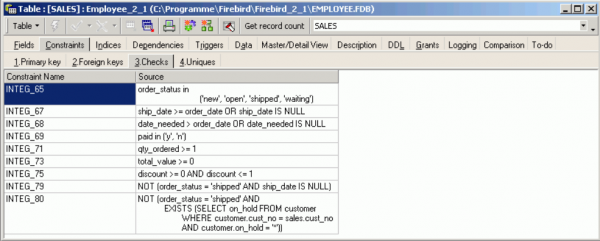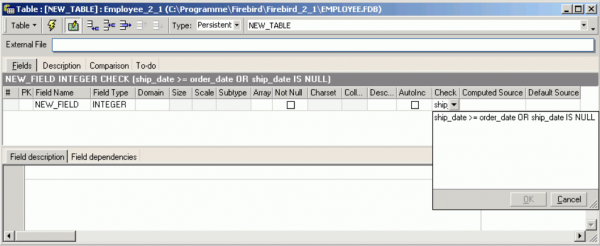Check constraint
A check is a database examination, which ensures data consistency in the tables among each other. It can be executed automatically and so ensures that data contents are kept consistent by testing them before they are stored in the database.
The check constraint option enables each data set to be examined for validation of the expression in brackets following the check constraint. Check constraints in tables are identical to check constraints in domains.
A check constraint can be specified for each column in a table, to guarantee the mechanism described above. It includes an expression that must be true, so that the data set following an insert or update can be written. The field contents must be included in the permissible values, which can be specified in a list. It is also possible to test the value for a minimum and maximum value. Furthermore the value can be compared to values in other columns, in order to test dependencies.
A check constraint can only examine the values in the current data set. When simultaneously inserting or altering multiple data sets, a check constraint can only guarantee one data integrity at a time at data set level.
If other data sets are referenced in the check, these could have been modified by another user at the time of entry, and therefore possibly have become invalid, even though the check constraint's test approved the data set. At the time of a check constraint validation, other data is only read for the check. For this reason, the values for the current operating sequence remain constant, even if another user has modified one of the values already referenced for validation.
A check constraint can be created directly when creating a table. When creating a check constraint, the following criteria should be taken into consideration:
- A check constraint cannot reference a domain.
- A table column can only contain one check constraint.
- A check constraint defined by a domain cannot be overridden by a local check constraint. However additional constraints can be specified.
In a check definition the VALUE keyword represents the value of the respective table column. The value examination is generally performed when inserting or updating this table column. The Check Value options permit diverse operations (please refer to Comparison Operators for a full list of possible operators).
Referential integrity declarations and primary key definitions are special check constraint compositions.
Only one constraint is permitted per column. If the column is based on a domain containing a constraint, both check constraints are active.
The specification of the keyword CONSTRAINT and the name are optional for all constraints. If no name is specified, Firebird/InterBase® generates a name automatically. All constraint names are stored in a system table called DB$RELATION_CONSTRAINTS.
It is only necessary to name constraints, if they are to be deactivated at a later date using the ALTER TABLE DROP statement.
Please note that if you want to change the CHECK constraint for a domain that already has a constraint defined, the existing constraint must first be dropped and then the new one added. ADD CHECK does not replace the current constraint with the new one. It is also important to realize that altering a CHECK constraint does not cause existing database rows to be revalidated; CHECK constraints are only validated when an INSERT or UPDATE is performed. One way of overcoming this limitation is to perform an UPDATE query using a dummy operation. If existing rows violate the new CHECK constraint, the query fails. These rows can then be extracted by performing a SELECT.
Check constraints and NULLs
If a CHECK constraint resolves to NULL, Firebird versions before 2.0 reject the input. Following the SQL standard to the letter, Firebird 2.0 and above let NULLs pass and only consider the check failed if the outcome is false.
This change may cause existing databases to behave differently when migrated to Firebird 2.0+. Carefully examine your CREATE/ALTER TABLE statements and add and XXX is not null predicates to your CHECKs if they should continue to reject NULL input.
Please refer to the Firebird 2.0 Language Reference Update chapter, CHECK accepts NULL outcome for further information.

